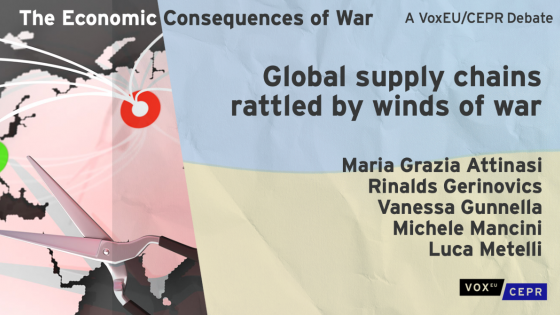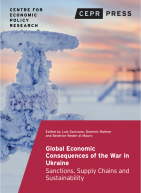Editors' note: This column is taken from a new CEPR eBook, Supporting Ukraine: More critical than ever, available to download here.
The Russian invasion of Ukraine has brought the link between war and international trade back into the spotlight. For some, it calls into question the pacifying effect of globalisation. For others, the trade sanctions against Russia, by increasing the cost of war for Russia, could encourage Putin to change his strategy and push him to negotiate. For the first time, these sanctions take the form not only of an embargo that affect the quantities exported, but also a maximum price on the Russian oil exported. In any case, this war is disrupting world trade, with repercussions on value chains and on the world prices of energy, raw materials, and agricultural products (Metelli et al. 2022), both in rich countries and in the most fragile poor countries (McGuirk and Burke 2022). Today, it is the immense commercial entanglement of economies that is spreading the human cost of war far beyond Ukraine's borders (Garicano et al. 2022).
The link between trade and military conflict is complex and ambiguous. One fact has been well established since the end of WWII, however, and it holds true in the case of the Ukraine conflict: war persistently damages trade links between countries, but does not eliminate them. In an empirical study we conducted in 2008 (Martin et al. 2008) and which was subsequently corroborated by others, we estimated that on average since WWII, military conflict rapidly reduces trade between belligerents by an order of magnitude of around 35%. The ‘return to normal’ in terms of trade once the conflict is over takes between 15 and 20 years. In the case of the 2014 conflict between Ukraine and Russia, bilateral trade was reduced but not eliminated. Even in the midst of conflict, trade continues. Moreover, a conflict can reduce trade not only between the warring parties but also between them and the rest of the world. Since the war began, Russian imports have fallen (partly due to sanctions) from Western countries (which had already been the case in 2014) but also from Asian countries.
Wars thus have, beyond the human cost, an economic cost. Montesquieu's belief in “le doux commerce” which has the "natural effect of bringing about peace" may be partly based on this economic calculation. If leaders take these costs of destroying trade into account, even partially and in conjunction with a host of other non-economic factors, then they will be more likely to prevent a conflict from escalating into a military confrontation; and all the more so if their country is open to international trade. This peacemaking effect of trade between two countries has been empirically verified after WWII. European integration is an emblematic case. In fact, it can be noted that trade flows between Ukraine and Russia decreased between 2014 and 2022. Ukraine spent about 17% of its expenditure on Russian goods in 2010, compared to less than 7% in 2018. During the same period, the share of Russian consumption from Ukraine was almost divided by three.
But to deduce from this that globalisation is always a factor of peace or that the decrease in trade flows is a factor of conflict would be wrong. By increasing trade flows further afield, multiplying partners, and reducing local economic dependence on nearby countries with which conflicts are most frequent, globalisation has been able to reduce the economic cost of a regional conflict. In fact, the number of such conflicts has increased with the growth of multilateral trade. At the same time that bilateral trade relations between Ukraine and Russia were weakening, both countries were increasing their trade with the rest of the world: between 2010 and 2018, Ukraine increased the share of its spending on goods from the rest of the world by about 11 percentage points (a significant portion of which came from the EU). Russia reduced its dependence on European imports, but increased imports from outside the EU and outside Ukraine by almost 3 percentage points.
In the area of energy, the EU's (and particularly Germany's) commercial dependence on Russia illustrates another dimension of the complexity of the links between trade and conflict. This dependence was partly orchestrated by Russia and has certainly delayed sanctions against Moscow. The embargo on oil countries was not implemented until the end of 2022 and it was the Russians who took the initiative to reduce gas exports. Thus, it is likely that by increasing the cost to Europe of possible sanctions, Europe's dependence on Russian energy has facilitated Putin's decision to attack Ukraine. In this case, it is trade which, through the dependence it generates, becomes a weapon of war.
It will be retorted that these mechanisms assume the rationality of political actors weighing the costs and benefits of a conflict and that a dictator such as Putin does not give the same weight to the human and economic cost of going to war as a leader of a democratic state. This is certainly true, but even dictatorships are sensitive to the economic impact of their decisions. If this were not the case, then the whole logic of Western sanctions against Russia would falter. We still believe that, even if imperfect, the trade sanctions against Russia should be strengthened with the objective to increase the cost for Russia of the war against Ukraine.
Trade (and more broadly, economic interests) is only one factor among others in the dynamics of escalation or containment of armed conflicts. But it is one of the levers on which we can act directly.
From this point of view, the war in Ukraine invites us to go beyond the purely mercantile vision of globalisation that has prevailed since the 1990s. From now on, the face of trade policy has changed: geopolitical risk must be fully taken into account in the architecture of future trade agreements. In the case of Ukraine, reconstruction will require strong growth and therefore strong trade flows. However, even after the end of war and as long as Russia remains aggressive, Ukraine will have to massively redirect its trade to the West and the EU. But, if at some point in the future the regime in Moscow changes, Ukraine should be able to restore its trade ties with Russia to set the geopolitical conditions for a smoother relationship in the long term. However, the size and urgency of the task of reconstruction requires quickening the integration process with the EU to benefit as quickly as possible from the growth benefits of trade. In other words, the institutional challenge for Ukraine and EU is to strengthen trade sanctions against Russia, build an architecture of trade agreements with the prime objective of reconstruction of Ukraine in sight and a variable geometry according to political developments in Russia.
References
Garicano, L, D Rohner and B Weder di Mauro (2022), Global Economic Consequences of the War in Ukraine: Sanctions, Supply Chains and Sustainability, CEPR Press.
Martin, P, T Mayer and M Thoenig (2008), “Make Trade Not War?”, The Review of Economic Studies 75(3): 865–900.
McGuirk, E and M Burke (2022), “War in Ukraine, world food prices, and conflict in Africa”, VoxEU.org, 26 May.
Metelli , L, M Mancini, R Gerinovics, V Gunnella and M Grazia Attinasi (2022), “Global supply chains rattled by winds of war”, VoxEU.org, 8 June.






